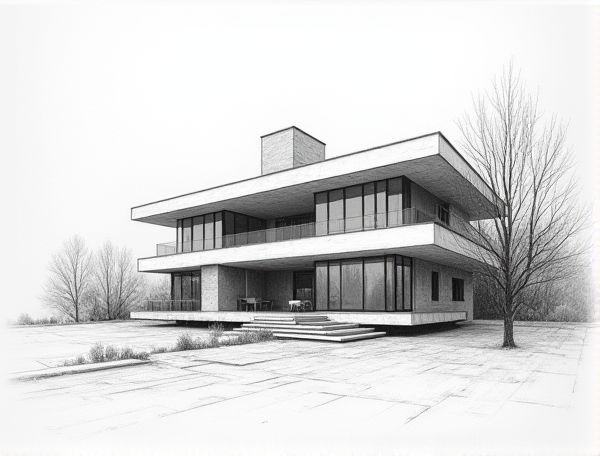
Photo illustration: Bauhaus home design with ribbon windows
Bauhaus home design emphasizes simplicity and functionality, featuring ribbon windows that stretch horizontally to flood spaces with natural light and create seamless indoor-outdoor connections. Discover how incorporating these sleek, linear windows can transform Your living environment by reading more in the article.
Introduction to Bauhaus Home Design
Bauhaus home design emphasizes minimalism, functional form, and the integration of art and technology, reflecting principles developed by the German Bauhaus School between 1919 and 1933. Characterized by clean lines, open floor plans, and the use of industrial materials like steel and glass, Bauhaus homes prioritize efficient space utilization and understated aesthetics.
Key Principles of Bauhaus Architecture
Bauhaus architecture emphasizes functionality, simplicity, and the integration of art, craft, and technology. Your home design benefits from clean lines, open floor plans, and the use of modern materials like steel, glass, and concrete to create a seamless connection between interior and exterior spaces. This style prioritizes practical living environments without sacrificing aesthetic appeal, ensuring your space is both efficient and visually balanced.
The Significance of Ribbon Windows
Ribbon windows enhance natural lighting and provide expansive exterior views, significantly improving your home's aesthetic and energy efficiency. These continuous horizontal windows maximize wall space for daylight distribution, creating a seamless connection between indoor and outdoor environments. Incorporating ribbon windows into your design elevates architectural appeal while optimizing ventilation and reducing reliance on artificial lighting.
Historical Evolution of Ribbon Windows
Ribbon windows, first popularized by Le Corbusier in the 1920s, revolutionized modernist architecture by emphasizing horizontal lines and maximizing natural light. Their historical evolution traces a shift from traditional segmented windows to continuous glass strips that enhance facade uniformity and interior openness.
Bauhaus Aesthetics: Form Meets Function
Bauhaus aesthetics emphasize simplicity and geometric forms that seamlessly integrate function and design, creating spaces where every element serves a practical purpose while maintaining visual harmony. This approach prioritizes clean lines, minimal ornamentation, and the use of industrial materials, resulting in homes that blend artistic expression with efficient living.
Integrating Ribbon Windows in Modern Homes
Ribbon windows enhance modern homes by providing continuous horizontal light and unobstructed panoramic views, boosting both aesthetics and natural ventilation. Your interior will benefit from increased daylight and a sleek, minimalist design that complements contemporary architectural styles.
Materials and Construction Techniques
Selecting sustainable materials such as bamboo, reclaimed wood, and recycled steel significantly enhances home durability and environmental impact. Advanced construction techniques like modular building and 3D printing improve efficiency, reduce waste, and allow for precise customization. Incorporating energy-efficient insulation materials and smart structural designs ensures optimal thermal performance and long-term cost savings.
Energy Efficiency of Ribbon Windows
Ribbon windows enhance energy efficiency by allowing consistent natural light across rooms, reducing dependence on artificial lighting and lowering electricity consumption. Their narrow, horizontal design supports optimal ventilation, contributing to improved indoor air quality and temperature regulation. High-performance glazing options for ribbon windows further minimize heat loss and gain, promoting sustainable temperature control and reducing HVAC energy costs.
Iconic Bauhaus Homes with Ribbon Windows
Iconic Bauhaus homes with ribbon windows showcase minimalist design and functional aesthetics, emphasizing horizontal lines and natural light. These ribbon windows wrap continuously around corners, enhancing spatial flow and connecting interior spaces to the outdoors. Your home can achieve modern elegance and efficiency by incorporating these signature Bauhaus elements.
Future Trends in Bauhaus-Inspired Designs
Future trends in Bauhaus-inspired home designs emphasize minimalist aesthetics combined with sustainable materials such as recycled steel and bamboo composites to enhance eco-friendliness. Smart home integration with clean lines and geometric shapes reflects the Bauhaus philosophy of functionality merged with modern technology. Urban living spaces increasingly adopt modular Bauhaus furniture to maximize space efficiency while preserving the style's iconic simplicity.
 homedesy.com
homedesy.com